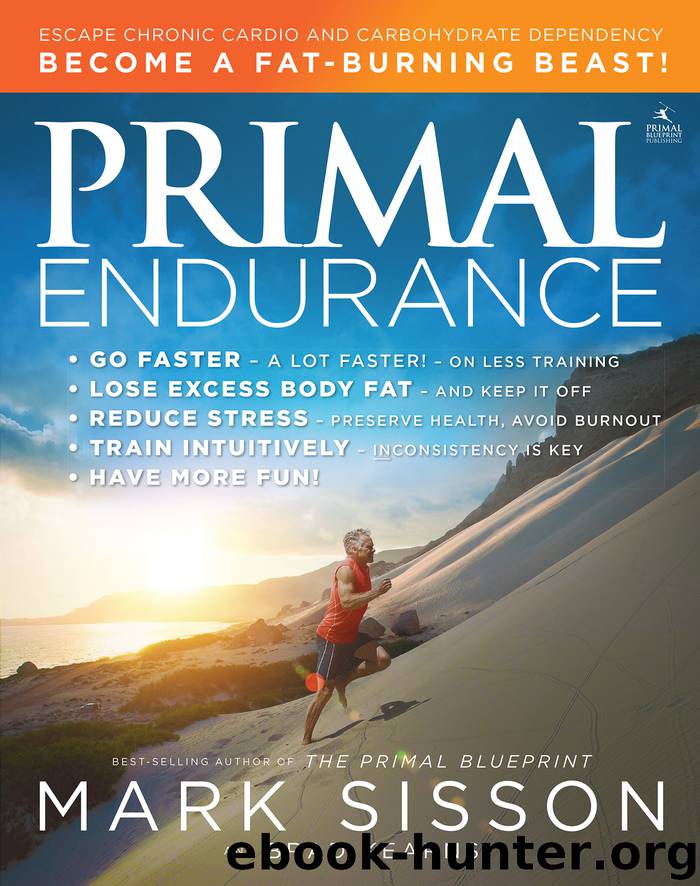Primal Endurance by Mark Sisson

Author:Mark Sisson
Language: eng
Format: epub
Publisher: Primal Nutrition, Inc.
Published: 2016-02-14T16:00:00+00:00
“Endurance athletes seem to care only about time, disregarding the important subtleties of spinal alignment, musculoskeletal mobility, breathing patterns, recovery techniques, and sleeping habits.”
—Dr. Kelly Starrett
Recovery is compromised because your body is still reeling from the tension caused by spending hours training in a misaligned position during the time it should be getting relaxation and restoration. The overstimulation of the sympathetic nervous system results in prolonged elevation of cortisol and excessive stress on the adrenal glands—fatal flaws for endurance athletes trying to manage their training amidst hectic daily schedules. Starrett mentions that many athletes grind their teeth at night, a sign of an over-stimulated sympathetic nervous system that can’t calm down and enable sleep to happen smoothly.
After a busy day of life and training, the parasympathetic system—often called the “rest-and-digest” system, in contrast to the “fight-or-flight” sympathetic—should kick into gear and help you relax, unwind, digest and assimilate nutrients, and eventually transition comfortably into a good night’s sleep. If you can relate to having more difficulty unwinding after a particularly stressful day at work, the same is true for unwinding after an unnecessarily stressful, misaligned workout.
Even if your session was enjoyable and comfortably paced, misalignment during the session overactivates and prolongs the fight-or-flight impact of the session. For this reason, Starrett recommends devoting fifteen minutes of each endurance workout to working on correct positioning and alignment. This might include those often overlooked running drills (such as hopping, high knees, or kickouts) that help your nervous system integrate and preserve correct form in the midst of fatigue. Similarly, exceeding aerobic maximum heart rate too often and training in a chronic pattern also promotes sympathetic dominance and eventual burnout. Meanwhile, the parasympathetic system can be stimulated by stretching, foam rolling, and massage therapy, all important big-picture elements of the endurance athlete’s training program.
“This is why it’s time to look beyond the straightforward training parameters and look at the subtleties of spinal alignment, musculoskeletal mobility, breathing patterns, recovery techniques, and sleeping habits to pursue performance breakthroughs,” Starrett argues. “Whatever activity we are doing, we need to put our body in a position where it can generate the most force, and the most mechanical ventilation efficiency. Unfortunately, this stuff is subtle. You might not notice how your breathing is impinged or how you have super tight calves, because the immediate sensations of pain are not there. Instead, you just go home from races wondering why you keep getting beaten by your training partner!”
Starrett continues, “Resistance training and also complementary movement and mobility practices such as yoga, Pilates, CrossFit, kettle-bells, and so forth, are essential for an endurance athlete. As you fatigue, you want to fatigue into safe mechanical positions and have your efficiency increase, not decrease. But unfortunately, when you fatigue, your proprioception gets blown out, so you don’t even realize your technique is falling apart. I’ll observe people in the gym, even world-class athletes, and say, ‘Hey, your back is starting to round, better stop.’ They don’t even believe me—they have to see
Download
This site does not store any files on its server. We only index and link to content provided by other sites. Please contact the content providers to delete copyright contents if any and email us, we'll remove relevant links or contents immediately.
How to Be a Bawse: A Guide to Conquering Life by Lilly Singh(7154)
Deep Work by Cal Newport(6563)
The Longevity Diet by Valter Longo(4856)
The Fat Loss Plan by Joe Wicks(4619)
The Four-Pack Revolution by Chael Sonnen & Ryan Parsons(3791)
The Ultimate Bodybuilding Cookbook by Kendall Lou Schmidt(3706)
The French Women Don't Get Fat Cookbook by Mireille Guiliano(3410)
Super Food Family Classics by Jamie Oliver(3245)
Not a Diet Book by James Smith(3149)
Turn Up Your Fat Burn! by Alyssa Shaffer(3057)
Factfulness_Ten Reasons We're Wrong About the World_and Why Things Are Better Than You Think by Hans Rosling(3046)
Self-Esteem by Matthew McKay & Patrick Fanning(2952)
Tom Kerridge's Dopamine Diet: My low-carb, stay-happy way to lose weight by Kerridge Tom(2951)
Body Love by Kelly LeVeque(2904)
The Unbecoming of Mara Dyer by Michelle Hodkin(2859)
The Fat Chance Cookbook by Robert H. Lustig(2641)
Tone Your Tummy Type by Denise Austin(2632)
LL Cool J's Platinum 360 Diet and Lifestyle by LL Cool J(2582)
Men's Health Best by Men's Health Magazine(2388)
